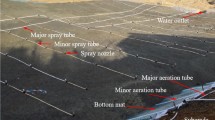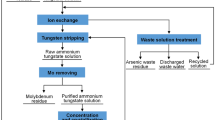Abstract
To design heap biooxidation process, it is necessary to understand its internal rules. The heap biooxidation of gold ore from Anhui province was researched in this study. The results showed that the main microorganisms in the heap were A. ferrooxidans, F. acidiphilum and L. ferrodiazotrophum. Under their combined action, gold leaching extent rose from 35.62% to 78.08% in 80 d. Boltzmann model matches the actual oxidation effect better and the model equations were obtained. The model predicted that the oxidation extents of arsenic and sulfur are 58.577% and 42.122% after one year, and the gold leaching extent was 80.40%. The arsenic and sulfur oxidation extents, and gold leaching extent were all linearly correlated. It is more reliable to predict gold leaching extent by sulfur oxidation extent. These results provided good guidance for practical application in the actual production.
摘要
为了优化生物堆浸氧化设计, 必须深入了解内在规律. 本研究对安徽省某含砷金矿生物堆浸氧化过程进行分析讨论, 结果表明: 堆中主要微生物为 A. ferrooxidans, F. acidiphilum 和 L. ferrodiazotrophum 等. 在它们的协同作用下, 80 天后堆中矿石金浸出率由 35.62%升高至78.08%. Boltzmann 模型对实际氧化结果的拟合更佳, 并得出了相应的模型方程. 用模型预测 1 年后砷、 硫氧化率分别为 58.577%和 42.122%, 金浸出率为 80.40%. 分析结果表明砷氧化率、 硫氧化率和金浸出率均为线性相关关系, 用硫氧化率预测金浸出率更精确. 这些结果为生物堆浸氧化的实际应用提供了很好的指导.
Similar content being viewed by others
References
CERDÃ J, GONZÃLEZ S, RIOS J M, QUINTANA T. Uranium concentrates bioproduction in Spain: A case study [J]. FEMS Microbiology Reviews, 1993, 11(1-3): 253–259. DOI: https://doi.org/10.1111/j.1574-6976.1993.tb00292.x.
RIEKKOLA-VANHANEN M. Talvivaara mining company — From a project to a mine [J]. Minerals Engineering, 2013, 48: 2–9. DOI: https://doi.org/10.1016/j.mineng.2013.04.018.
ROBERTO F F. Commercial heap biooxidation of refractory gold ores—Revisiting Newmont's successful deployment at Carlin [J]. Minerals Engineering, 2017, 106: 2–6. DOI: https://doi.org/10.1016/j.mineng.2016.09.017.
LIU Xing-yu, CHEN Bo-wei, CHEN Jing-he, ZHANG Ming-jiang, WEN Jian-kang, WANG Dian-zuo, RUAN Ren-man. Spatial variation of microbial community structure in the Zijinshan commercial copper heap bioleaching plant [J]. Minerals Engineering, 2016, 94: 76–82. DOI: https://doi.org/10.1016/j.mineng.2016.05.008.
BRIERLEY C L. How will biomining be applied in future? [J]. Transactions of Nonferrous Metals Society of China, 2008, 18(6): 1302–1310. DOI: https://doi.org/10.1016/s1003-6326(09)60002-9.
JALALI F, FAKHARI J, ZOLFAGHARI A. Response surface modeling for lab-scale column bioleaching of low-grade uranium ore using a new isolated strain of Acidithiobacillus Ferridurans [J]. Hydrometallurgy, 2019, 185: 194–203. DOI: https://doi.org/10.1016/j.hydromet.2019.02.014.
TAVAKOLI H Z, ABDOLLAHY M, AHMADI S J, DARBAN A K. Enhancing recovery of uranium column bioleaching by process optimization and kinetic modeling [J]. Transactions of Nonferrous Metals Society of China, 2017, 27(12): 2691–2703. DOI: https://doi.org/10.1016/S1003-6326(17)60298-X.
ASPIAZU C L, AGUIRRE P, HEDRICH S, SCHIPPERS A. Microbial community analysis inside a biooxidation heap for gold recovery in equador [J]. Solid State Phenomena, 2017, 262: 135–138. DOI: https://doi.org/10.4028/www.scientific.net/SSP.262.135.
HU Jie-hua, HUANG Huai-guo, XIE Hong-zhen, GAN Li-hui, LIU Jian, LONG Min-nan. A scaled-up continuous process for biooxidation as pre-treatment of refractory pyrite-arsenopyrite gold-bearing concentrates [J]. Biochemical Engineering Journal, 2017, 128: 228–234. DOI: https://doi.org/10.1016/j.bej.2017.10.001.
BOUFFARD S C, DIXON D G. Modeling the performance of pyritic biooxidation heaps under various design and operating conditions [J]. Hydrometallurgy, 2009, 95(3, 4): 227–238. DOI: https://doi.org/10.1016/j.hydromet.2008.06.002.
MCBRIDE D, GEBHARDT J E, CROSS M. A comprehensive gold oxide heap leach model: Development and validation [J]. Hydrometallurgy, 2012, 113-114: 98–108. DOI: https://doi.org/10.1016/j.hydromet.2011.12.003.
ROBERTSON S. Development of an integrated heap leach solution flow and mineral leaching model [J]. Hydrometallurgy, 2017, 169: 79–88. DOI: https://doi.org/10.1016/j.hydromet.2016.12.010.
MCBRIDE D, CROFT T N, CROSS M, BENNETT C, GEBHARDT J E. Optimization of a CFD—Heap leach model and sensitivity analysis of process operation [J]. Minerals Engineering, 2014, 63: 57–64. DOI: https://doi.org/10.1016/j.mineng.2013.11.010.
ROLFE M D, RICE C J, LUCCHINI S, PIN C, THOMPSON A, CAMERON A D S, ALSTON M, STRINGER M F, BETTS R P, BARANYI J, PECKM W, HINTONA J C D. Lag phase is a distinct growth phase that prepares bacteria for exponential growth and involves transient metal accumulation [J]. Journal of Bacteriology, 2012, 194(3): 686–701. DOI: https://doi.org/10.1128/jb.06112-11.
SOTO P, MENESES C, COMTADOR Y, GALLEGUILLOS P, DEMERGASSO C, SERÓN M. Characterization of oxidizing activity of a microbial community in an industrial bioleaching heap [J]. Advanced Materials Research, 2009, 71-73: 59–62. DOI: https://doi.org/10.4028/www.scientific.net/AMR.71-73.59.
GAO Qi-yu, TANG De-ping, SONG Peng, ZHOU Jian-ping, LI Hong-yu. Characterization of acylated homoserine lactone derivatives and their influence on biofilms of Acidithiobacillus ferrooxidans BY-3 under arsenic stress [J]. Journal of Central South University, 2020, 27(1): 52–63. DOI: https://doi.org/10.1007/s11771-020-4277-2.
MA Li-yuan, WANG Hong-mei, WU Jiang-jun, WANG Yu-guang, ZHANG Du, LIU Xuan-duan. Metatranscriptomics reveals microbial adaptation and resistance to extreme environment coupling with bioleaching performance [J]. Bioresource Technology, 2019, 280: 9–17. DOI: https://doi.org/10.1016/j.biortech.2019.01.117.
HE Zhi-guo, GAO Feng-ling, ZHAO Jian-cun, HU Yue-hua, QIU Guan-zhou. Insights into the dynamics of bacterial communities during chalcopyrite bioleaching [J]. FEMS Microbiology Ecology, 2010, 74(1): 155–164. DOI: https://doi.org/10.1111/j.1574-6941.2010.00943.x.
WANG Jun, ZHU Shan, ZHANG Yan-sheng, ZHAO Hong-bo, HU Ming-hao, YANG Cong-ren, QIN Wen-qing, QIU Guan-zhou. Bioleaching of low-grade copper sulfide ores by Acidithiobacillus ferrooxidans and Acidithiobacillus thiooxidans [J]. Journal of Central South University, 2014, 21: 728–734. DOI: https://doi.org/10.1007/s11771-014-1995-3.
HEDRICH S, JOULIAN C, GRAUPNER T, SCHIPPERS A, GUÉZENNEC A G. Enhanced chalcopyrite dissolution in stirred tank reactors by temperature increase during bioleaching [J]. Hydrometallurgy, 2018, 179: 125–131. DOI: https://doi.org/10.1016/j.hydromet.2018.05.018.
WANG Zhao-bao, LI Ya-qing, LIN Jian-qun, PANG Xin, LIU Xiang-mei, LIU Bing-qiang, WANG Rui, ZHANG Cheng-jia, WU Yan, LIN Jian-qiang, CHEN Lin-xu. The two-component system RsrS-RsrR regulates the tetrathionate intermediate pathway for thiosulfate oxidation in Acidithiobacillus caldus [J]. Frontiers in Microbiology, 2016, 7: 1–15. DOI: https://doi.org/10.3389/fmicb.2016.01755.
GARCÍA-MOYANO A, GONZÁLEZ-TORIL E, MORENO-PAZ M, PARRO V, AMILS R. Evaluation of Leptospirillum spp. in the Río Tinto, a model of interest to biohydrometallurgy [J]. Hydrometallurgy, 2008, 94(1-4): 155–161. DOI: https://doi.org/10.1016/j.hydromet.2008.05.046.
LI Jia-feng, TONG Lin-lin, XIA Yu, YANG Hong-ying, SAND Wolfgang, XIE Hong-zhen, LAN Bi-bo, ZHONG Shui-ping, AUWALU Ali. Microbial synergy and stoichiometry in heap biooxidation of low-grade porphyry arsenic-bearing gold ore [J]. Extremophiles, 2020, 24(3): 355–364. DOI: https://doi.org/10.1007/s00792-020-01160-6.
MARCHEVSKY N, URBIETA M S, BERNARDELLI C, MAS M, DONATI E R. Zinc recovery during refractory ore biooxidation by an indigenous consortium [J]. International Journal of Mineral Processing, 2015, 138: 30–37. DOI: https://doi.org/10.1016/j.minpro.2015.03.009.
RUAN Ren-man, ZOU Gang, ZHONG Shui-ping, WU Zeng-ling, CHAN B K C, WANG D Z. Why Zijinshan copper bioheapleaching plant works efficiently at low microbial activity—Study on leaching kinetics of copper sulfides and its implications [J]. Minerals Engineering, 2013, 48: 36–43. DOI: https://doi.org/10.1016/j.mineng.2013.01.002.
Author information
Authors and Affiliations
Corresponding author
Additional information
Foundation item: Project(U1608254) supported by the Special Fund for the National Natural Science Foundation of China; Projects(ZJKY2017(B)KFJJ01, ZJKY2017(B)KFJJ02) supported by the Zijin Mining Group Co., Ltd, China
Rights and permissions
About this article
Cite this article
Li, Jf., Zhong, Sp., Tong, Ll. et al. Modeling heap biooxidation of arsenic-bearing gold ore. J. Cent. South Univ. 27, 1424–1431 (2020). https://doi.org/10.1007/s11771-020-4378-y
Received:
Accepted:
Published:
Issue Date:
DOI: https://doi.org/10.1007/s11771-020-4378-y




